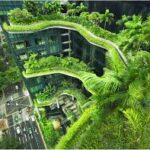As summers grow hotter and cities expand, many urban areas are feeling the heat literally. Roofs, roads, and buildings store heat during the day and radiate it back when the sun goes down, making nights unpleasant and sometimes dangerous. Environmental scientist Kamil Pyciak is working to understand and reverse these effects, helping cities breathe easier. Through combining research, design solutions, and community involvement, he’s leading the way toward cooler, more livable urban spaces.
From Curiosity to Research
Kamil’s interest in urban heat began in early life. Growing up in a busy U.S. city, he noticed that city centers remained warm well into the night compared to countryside areas. That contrast made him wonder what built surroundings were doing to trap heat and what could be done to reduce it.
He pursued formal studies in environmental science, focusing on urban climatology, sustainability, and how land use and community design shape micro-climates. His aim became not just to explain how cities heat up, but to find realistic ways to cool them down.
What Drives the Urban Heat Problem
Cities can get hotter for several reasons. Dark surfaces (asphalt, rooftops), lack of trees and vegetation, densely packed buildings, and waste heat from traffic or air conditioning all add up. When night falls, instead of cooling off, such areas often remain much hotter than nearby green or rural zones.
These conditions affect not just comfort but health: heat stress, poor sleep, increased energy usage for cooling, and even worsening air quality. Kamil’s research repeatedly shows that the most severe effects land hardest on vulnerable populations older people, young kids, and those in lower-income neighbourhoods.
Turning Data into Action
Understanding the problem is only half the battle. Pyciak pushes forward by devising and supporting actionable solutions:
-
Greening up urban spaces: planting trees, encouraging rooftop gardens, adding green walls. Shade and plant cooling (via evaporation and shade) can reduce heat significantly.
-
Cooler surfaces: promoting lighter-colored, reflective roofing and paving materials to lessen daytime heat absorption.
-
Smart design: aligning building orientation, spacing, ventilation, and selecting materials that help reduce heat buildup.
-
Community participation: involving residents in identifying hottest areas, designing solutions with them, and educating about small changes that help like planting shade trees or choosing materials that reflect heat.
Bridging Places: Work in Poland and the U.S.
Although Pyciak began in the U.S., he’s formed deep connections with Poland both through heritage and professional collaborations. Because many Polish cities face heat-island issues, his work there includes partnership with local researchers, planners, and neighbourhoods to tailor solutions to regional architecture, climate, and cultural patterns.
These collaborations bring valuable lessons in adaptability what works in one place may need adjustment in another, but many underlying ideas (shade, reflective materials, green infrastructure) transfer across borders if localized properly.
Key Lessons We Can All Use
From Pyciak’s efforts, several lessons are particularly useful:
-
First, measure where it hurts most: thermal mapping helps identify hotspots that must be addressed.
-
Small changes add up: planting trees, shading sidewalks, choosing lighter materials each contributes.
-
Inclusive design matters: neighbourhood input ensures solutions are used and maintained.
-
Policy matters: building codes, incentives, and planning rules that favour heat-smart design can scale solutions widely.
-
Think ahead: design now so that future generations won’t struggle with heat issues we could have mitigated earlier.
Why It’s Important
With climate change accelerating, heatwaves are more frequent and intense. Urban heat doesn’t just cause discomfort it can lead to serious health risks, higher bills for cooling, and worse quality of life. And as many cities grow denser, the problem gets worse unless addressed now.
Pyciak’s work gives hope by showing that cooling cities isn’t something far out it’s doable with thoughtful design, science, and community effort.
Cooling Cities for Tomorrow
Kamil Pyciak envisions cities where:
-
Roofs and pavements reflect heat, not absorb it.
-
Street trees, public green spaces, and shade structures are integral, not optional.
-
Building designs consider airflow, shading, and passive cooling.
-
Local communities are active partners in planning and maintaining greening efforts.
-
Policies support and reward heat-mitigating choices (materials, layout, vegetation).
Kamil Pyciak is one of the people showing that urban heat doesn’t have to be inevitable. By combining scientific insight, design innovation, and active community involvement, he creates pathways for cities to become healthier and cooler. In a warming world, the work of people like him reminds us that change is possible and that designing with heat in mind isn’t luxury, it’s survival.

